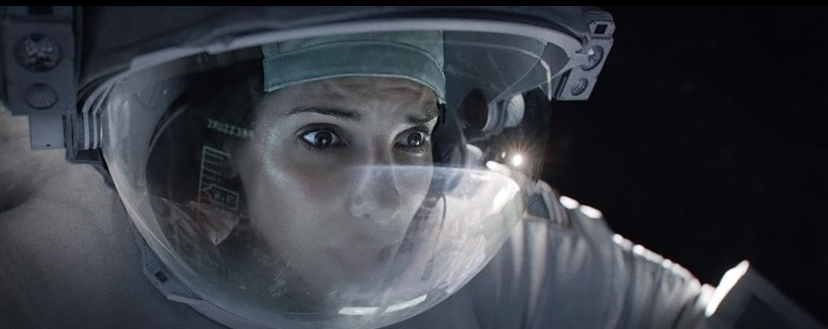Stone’s Struggle, Our Own
“Gravity” transcends its thrilling space narrative, inviting us to contemplate the human spirit’s profound capacity for resilience and transformation. Dr. Ryan Stone, our protagonist, grapples with the depths of despair after a devastating accident. Lost in the vast emptiness of space, she confronts not just the physical dangers of the environment, but the crushing weight of grief and the terrifying possibility of oblivion.
Yet, amidst the darkness, flickers of hope ignite within her. Fragments of training, the fading echo of a supportive voice, and an unyielding will to survive propel her forward. This struggle mirrors our own, as we all face moments of immense hardship that threaten to engulf us. But Dr. Stone’s story resonates because it reminds us that even in the darkest moments, a tenacious spirit lies within, urging us to rise above the despair and fight for a new beginning.
Echoes in the Silence
Stone’s isolation is particularly poignant. Severed from her crewmates, her only lifeline is a faint radio transmission from Matt Kowalski. His unwavering belief in her becomes a beacon, mirroring the support systems that can carry us through life’s storms. This resonates with John 14:26, where the Holy Spirit is described as a “Helper” who guides and reminds us of what we know deep down. Kowalski, while not a perfect parallel, offers crucial encouragement at critical moments. Ultimately, however, these external voices fade, forcing us to draw upon the wellspring of strength within ourselves.
This concept evokes memories of pre-exam jitters. Crammed with knowledge from my teacher’s lectures, I was nonetheless alone in the exam hall. Survival then hinged on summoning that knowledge, trusting it would resurface to guide me. Similarly, Stone’s arsenal of training, memories, and survival instincts ultimately proves to be her most potent weapon against seemingly insurmountable odds.
Visual Storytelling
“Gravity” isn’t simply a story about surviving space; it’s a profound meditation on the human spirit’s ability to navigate life’s turbulent storms. The film masterfully utilizes visual metaphors to weave its narrative tapestry. Stone’s fetal position throughout the film is multifaceted. It signifies vulnerability and despair, but also a potential for renewal, mirroring the curled-up position of a fetus in the womb. This echoes the trials of childbirth: a violent struggle, a harsh new environment, yet ultimately, the promise of new life.
Refining the Spirit
Another powerful visual is Stone’s fiery re-entry into Earth’s atmosphere. Engulfed in flames, the scene evokes a metaphorical baptism by fire, representing a spiritual transformation for Dr. Stone. The Bible uses fire symbolically in various ways. In Isaiah 1:25, we read: “I will refine you with fire and remove all your impurities.” Dr. Stone’s fiery re-entry mirrors this concept.
Just as a goldsmith uses fire to purge impurities from gold, the trials of space force Dr. Stone to confront her fears and limitations. This connection to the story of the Goldsmith and the fire, popularized in Christian writings like those of Amy Carmichael (Learning of God), adds another layer of meaning to the scene. It suggests the possibility of Dr. Stone emerging not just changed, but potentially stronger and more resilient after her ordeal.
Furthermore, John the Baptist contrasts water baptism with the transformative baptism by fire, saying, “I baptize you with water for repentance. But after me comes one who is more powerful than I, whose sandals I am not worthy to carry. He will baptize you with the Holy Spirit and fire.” (Matthew 3:11) This baptism by fire represents spiritual empowerment and authority. While Dr. Stone’s ordeal doesn’t have direct spiritual overtones, the visual metaphor suggests her potential for emerging from the fiery crucible as a revitalized, more empowered individual.
From Darkness…Light
The film’s use of light and darkness further amplifies this theme of rebirth. Initially shrouded in darkness, both literally and figuratively, Stone reflects the crushing despair of her situation. This darkness evokes the fallow periods in life where change seems obscured, where seeds of growth are sown beneath the surface. However, as the film progresses, light plays an increasingly transformative role. As Stone makes difficult choices and fights for survival, glimpses of sunlight pierce through the darkness, symbolizing a flicker of hope rekindled within her. The breathtaking shot of Stone tethered amidst a sea of stars, bathed in the warm glow of Earth rising on the horizon, becomes the culmination of this transformation. Through her trials, Stone has confronted her fears, embraced her will to live, and emerges reborn – a testament to the indomitable human spirit.
Finding Solid Ground
The film’s parallels with the biblical story of Noah’s Ark further enrich the exploration of resilience. Like Noah, Dr. Stone faces a seemingly apocalyptic scenario and must defy extraordinary odds. Both characters must find solace amidst chaos, sustained by their determination and a flicker of hope. This isolation is a key theme for both, as are the places of refuge they ultimately find. Noah and his family are confined to the ark amidst a world transformed into a destructive ocean (Genesis 7:17-20). Similarly, Dr. Stone finds herself adrift in the unforgiving vastness of space, struggling to find sanctuary in a series of damaged or temporary shelters. The ark and the various space stations become symbols of refuge, essential for weathering the storm and allowing for the possibility of rebirth.
Both the floodwaters and Dr. Stone’s trials represent a complete upheaval, a shattering of the world as they knew it. Within this destruction, there’s the potential for radical transformation. Just as the flood reshapes the earth in the biblical story, Dr. Stone’s ordeal reshapes her inner landscape.
Finally, both stories emphasize endurance and the promise of a brighter future. Noah weathers months on the ark, his faith sustained by the hope of a renewed world (Genesis 8:10-12). Dr. Stone repeatedly faces seemingly impossible odds, her resilience fueled by the yearning for safety and a return to Earth. The rainbow that marks the end of the flood serves as a symbol of God’s covenant and promise of renewal (Genesis 9:12-17), a visual promise paralleled by the breathtaking sight of Earth that ultimately guides Dr. Stone home.
Just as Noah’s journey ultimately leads to a fresh start for humanity, “Gravity” reminds us that hope and resilience are essential for navigating life’s turbulent storms.
Conclusion: The Potential for Dawn
“Gravity” is more than just a sci-fi space thriller. It’s a fictional dream that contains cinematic reminders of the human spirit’s capacity for resilience and the potential for rebirth, even after the darkest nights of the soul.

